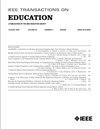Teaching Programming in Higher Education Using a Hybrid Project-Based Learning Approach
IF 2
2区 工程技术
Q2 EDUCATION, SCIENTIFIC DISCIPLINES
引用次数: 0
Abstract
Contribution: Results and conclusions on the use of a hybrid Project-Based Learning (PBL) approach to teaching programming in a higher education computing department. Background: PBL is a pedagogical approach that facilitates “learning by doing” and can create compelling educational experiences that enhance a student’s intrinsic motivation. Engagement can increase because students design their own unique projects, which have personal meaning and importance. PBL facilitates working with industrial clients to solve problems, which can create powerful extrinsic motivation. However, PBL can fail when students lack the experience and confidence to work as independent learners. Research Questions: 1) Can a hybrid PBL approach mitigate these problems by using a range of additional initiatives? These include, a wide range of on-demand learning resources, student mentoring, students collaborating with teachers to grade their own work, regular feedback milestones and scaffolding of learning via streaming. In this case streaming means offering students pathways through projects that require more or less independent research and project management. Methodology: A mixed methods study of a new hybrid approach to teaching programming. Findings: This article summarizes the author’s experience of implementing hybrid PBL within a university computing department, associated with improved student attainment and describes best practice, the advantages and the pitfalls.基于混合项目学习方法的高等教育编程教学
贡献:使用基于项目的混合学习(PBL)方法在高等教育计算机系进行编程教学的结果和结论。背景:PBL是一种促进“边做边学”的教学方法,可以创造引人注目的教育体验,增强学生的内在动机。因为学生设计自己独特的项目,这些项目具有个人的意义和重要性,所以参与度可以提高。PBL有助于与工业客户一起解决问题,这可以产生强大的外在动机。然而,当学生缺乏作为独立学习者的经验和信心时,PBL可能会失败。研究问题:1)混合PBL方法能否通过使用一系列额外的举措来缓解这些问题?这些措施包括:广泛的按需学习资源、学生指导、学生与教师合作为自己的作业打分、定期反馈里程碑和通过流媒体学习的框架。在这种情况下,流媒体意味着为学生提供通过项目或多或少需要独立研究和项目管理的途径。方法论:一种新的编程教学混合方法的混合方法研究。发现:本文总结了作者在大学计算系实施混合PBL的经验,并描述了最佳实践、优势和缺陷。
本文章由计算机程序翻译,如有差异,请以英文原文为准。
求助全文
约1分钟内获得全文
求助全文
来源期刊

IEEE Transactions on Education
工程技术-工程:电子与电气
CiteScore
5.80
自引率
7.70%
发文量
90
审稿时长
1 months
期刊介绍:
The IEEE Transactions on Education (ToE) publishes significant and original scholarly contributions to education in electrical and electronics engineering, computer engineering, computer science, and other fields within the scope of interest of IEEE. Contributions must address discovery, integration, and/or application of knowledge in education in these fields. Articles must support contributions and assertions with compelling evidence and provide explicit, transparent descriptions of the processes through which the evidence is collected, analyzed, and interpreted. While characteristics of compelling evidence cannot be described to address every conceivable situation, generally assessment of the work being reported must go beyond student self-report and attitudinal data.
 求助内容:
求助内容: 应助结果提醒方式:
应助结果提醒方式:


